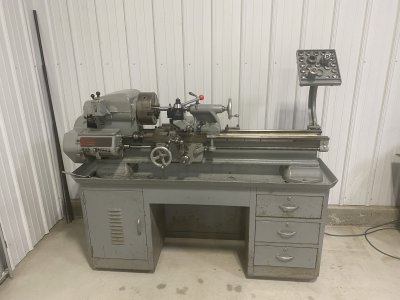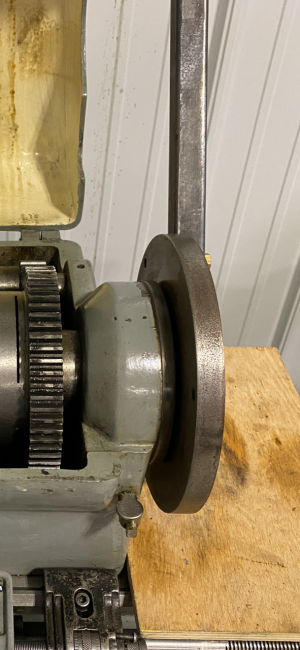- Joined
- Dec 24, 2020
- Messages
- 1,058
Good stuff...thanks. I think your assumption is correct...the lathe is really quite clean considering it's from the mid 1950s and I don't see any obvious rust, etc. I know it wasn't used much in the past 20 years or so as I bought it from the grandson of the previous owner, so that chuck has probably been on there a long, long time and who knows how many interrupted cuts it may have seen.I'm going to assume that this is in good condition, and "stuck", and that it's not rusted, corroded, and frozen in place. That means you have to throw out 99 percent of the ways that "always work" for getting stuck things apart. Good clean metal that's stuck is the way it is by an entirely different mechanism than things exposed to the elements, heat cycling, badly dissimilar metals, etc.
If you've got enough pressure against the thread that it won't move at this point, stop spraying the Kroil, or any oil. It's not gonna get where you need it until after the chuck is off. (If there were a gap there, it wouldn't be stuck.....). It's just making smoke.
Persistance usually gets things of that nature to move eventually. Constant "bumping" is what got it on as tight as it is in the first place, and will eventually get it to come loose.
Heat is an option. If "normal" ways fail, one really effective way is instead of heating and then trying to unscrew it fails... ESPECIALLY if you have what you have... The "outside" part is heavier than the "inside part", is to place it under tension BEFORE heating. Because the inside part is so relatively light (less thermal mass) it heats up a LOT easier. It obviously has good intimate contact... You don't get as good of a differential expansion. Take your lever arrangements, the bars and the collar, set up one against a brace, and the other loaded up with a small ratchet strap, maybe down to the table, and put some good tension on it, as if you were actually pulling on it. The longer the ratchet strap, the better. Maybe to a low place on the stand/table? There's some stretch in it, so the longer the tensioned secton of strap is, the more "distance" you'll get. You only need this to move a whisker, then it'll go. THEN, after you have a good "preload" in the right direction, start heating the backing plate all the way around, maybe an inch out from the threads. This way, when (if) you reach the breaking point, you won't loose it (by the spindle warming) as you go for the turning weapons. You can easily loose the "window" in a fraction of a second. Another thing is the heat it's self. Propane torches are not "that" hot, and it takes a while to warm things up. You might do a lot better, with less heat applied, if you had access to a stronger heat source. Something that will heat it faster, but have you in and out in seconds instead of minutes. Another valid thing to if it's possible, which I suspect you can, is to stuff the spindle with wet rags. If there's room, and it may or may not be possible), an ice cube or two inside the wet rag. Just like there's an amazing amount of energy (heat) involved in making steam from the water (which is what you want, that energy (heat) comes right driectly out of the spindle...), there's also a similarly large energy amount involved in the transition from ice to water. All that amounts to more "differential heating", which is in the end, what separates stuck things.
The trouble with turning something like that off of there is, you take away the "handle" that you want to use to get the last bits out. Hoop stresses are a pretty amazing thing, but it leaves you with a small bit of the back plate in this case, still just as stuck as it ever was, and even if it relaxed "some", there's no way to hang on to it. So you're left turning right to exposed threads. Very, very possible to do, but every chance of it not going quite to plan.
If it does come to turning it off, it's just turning. You'll end up making a LOT of chips to get there, but the goal would be to turn it down until you just (and only just) cut into the root off the female thread, but no deeper than the gap between that and the crest of the male thread, so you'll be left with a giant heli-coil threaded onto the spindle. At that , when the heli-coil bit of metal is separated from the continuous metal, you'll have broken the "hoop" through which the pressure is applied, the fit will be relaxed, and the remaining bits will come right out.
I'd still go for the heat though, especially if there's any way you can come up with a higher and faster heat source, but cooling the spindle will greatly improve the results. And help with not burning the oil out of the front spindle bearing.
I was thinking about preloading it and then adding heat, while putting ice cubes in the spindle, so I'm glad you mentioned that. I have an oxy/acetylene torch just feet away, so it sound like that might be the next step. Preload, hotter flame and some internal ice.
I thought about the issue of turning it down part way and then being able to get a handle on it. I'm a pretty proficient TIG welder with a good track record of welding cast iron, so my thought was turn it down until it's something like 3/16" thick, then tack weld a lever arm on it and it would be easy to heat it at that point if necessary since there would be so little left. Still, I'd like to avoid the mess, time and waste of the back plate if necessary so I'm going to stick with heat for a while longer.
Maybe not a beauty queen, but not an old rust bucket either. This reminds me, I need to replace the Sheldon badge (it's in a drawer)!




